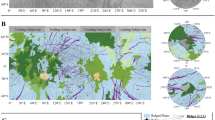Abstract
Magnetotelluric (MT) transfer functions, which carry information about the subsurface resistivity distribution, remain constant over time in geologically stable regions. However, recent results indicate the presence of significant seasonal changes in tipper/induction arrows irrespective of the geological processes. We have obtained the annual and seasonal variations in induction vectors at six observatories located in different geographical (island, inland, and coastal areas) and tectonic (cratonic, and passive/convergent margins) settings in India. Based on a 30-day period of data, the tipper/induction vectors are estimated by using 1-min magnetic variation data for 2 years at each site for a period range of 4–150 min. The average tipper amplitude variations range from 0.2 to 0.3 at coastal sites, from 0.1 to 0.2 at island sites, and < 0.1 at inland sites. The seasonal pattern at low-latitude sites is greatest at the summer solstice and smallest at the winter solstice, whereas at equatorial sites it is greatest at the winter solstice/autumnal equinox and smallest at the summer solstice. At low-latitude and equatorial sites, seasonal variation in the direction of the induction vectors is at the sharp conductivity contrast periods. The varying ranges of the seasonality of tipper amplitude and direction variations at different geological regimes are due to the interaction of the source field with the conductivity structure and the lateral changes in the conductivity around the particular site.






Similar content being viewed by others
Data availability
The data that support the findings of this study are available from the corresponding author upon reasonable request.
References
Agarwal, A. K., & Weaver, J. T. (1989). Regional electromagnetic induction around the Indian peninsula and Sri-Lanka; a three-dimensional numerical model study using the thin sheet approximation. Physics of the Earth and Planetary Interiors, 54, 320–331.
Anderson, C. W., Lanzerotti, L. J., & Maclennan, C. G. (1976). Local time variation of induction vectors as indicators of internal and external current systems. Geophysical Research Letters, 3, 495–498.
Anusha, E., Arora, K., Nagarajan, N., & Abdul Azeez, K. K. (2020). Constraints on the configuration of Andaman- Nicobar subduction zone from EM modeling. Tectonophysics. https://doi.org/10.1016/j.tecto.2020.228575
Araya Vargas, J., & Ritter, O. (2015). Source effects in mid-latitude geomagnetic transfer functions. Geophysical Journal International, 204(1), 606–630.
Arora, B. R., & Subba Rao, P. B. V. (2002). Integrated modeling of EM response functions from peninsular India and Bay of Bengal. Earth, Planets and Space, 54, 637–654.
Beamish, D. (1979). Source field effects on transfer functions at mid-latitudes. Geophysical Journal of the Royal Astronomical Society, 58, 117–134.
Br¨andlein, D., L¨uhr, H., & Ritter, O. (2012). Direct penetration of the interplanetary electric field to low geomagnetic latitudes and its effect on magnetotelluric sounding. Journal of Geophysical Research: Space Physics. 117 (A11).
Bury A. (2019). Temporal variations visible in induction arrows and their spatial distribution - preliminary results. Schmucker-Weidelt-Kolloquium Haltern am See, 23.–27.
Chapman, S., & Bartels, J. (1940). Geomagnetism. Oxford University Press, 2, xxvii. 1049. 63s.
Chave, A. D., & Thomson, D. J. (2003). A bounded influence regression estimator based on the statistics of the hat matrix. Journal of the Royal Statistical Society Series C, Royal Statistical Society, 52(3), 307–322.
Chave, A. D., & Thomson, D. J. (2004). Bounded influence estimation of magnetotelluric response functions. Geophysical Journal International, 157, 988–1006.
Constable, C. (2016). Earth’s electromagnetic environment. Surveys in Geophysics, 37(1), 27–45.
Ernst, T., Nowo˙zy´nski, K., & J´o´zwiak, W. (2020). The reduction of source effect for reliable estimation of geomagnetic transfer functions. Geophysical Journal International, 221, 415–430.
Ernst, T., Nowożyński, K., & Jóźwiak, W. (2022). Source effect impact on the magnetotelluric transfer functions. Annals of Geophysics, 65(1), GM104–GM104.
Everett, J. E., & Hyndman, R. D. (1967). Geomagnetic variations and electrical conductivity structure in south-western Australia. Physics of the Earth Planetary Interiors, 1, 24–34.
Gokarn, S. G., Gupta, G., & Rao, C. K. (2004). 2004, Geoelectric structure of the Dharwar Craton from magnetotelluric studies: Archean suture identified along the Chitradurga-Gadag schist belt. Geophysical Journal International, 158, 712–728. https://doi.org/10.1111/j.1365-246X.2004.02279.x
Harinarayana, T., Patro, B. P. K., Veeraswamy, K., Manoj, C., Naganjaneyulu, K., Murthy, D. N., & Virupakshi, G. (2007). Regional geoelectric structure beneath Deccan Volcanic Province of the Indian subcontinent using magnetotellurics. Tectonophysics, 445(1–2), 66–80. https://doi.org/10.1016/j.tecto.2007.06.010.
Kennett, B. L. N., & Widiyantoro, S. (1999). A low seismic wavespeed anomaly beneath northwestern India: A seismic signature of the Deccan plume? Earth and Planetary Science Letters, 165, 145–155.
Kumar, S. (2014). Tipper Magnitude: A Possible Indicator of Anomalous Conducting Zone. Journal of Geophysics, XXXV, 83–87.
Naidu, G. D., Manoj, C., Patro, P. K., Sreedhar, S. V., & Harinarayana, T. (2011). Deep electrical signatures across the Achankovil shear zone, Southern Granulite Terrain inferred from magnetotellurics. Gondwana Research, 20, 405–426.
Nityananda, N., Agarwal, A. K., & Singh, B. P. (1977). Induction at short period on the horizontal field variation in the peninsular India. Physics of the Earth and Planetary Interiors, 15, 5–9.
Nityananda, N., Rajagopal, A. S., Agarwal, A. K., & Singh, B.P. (1975). Induction in Short-period Events in the Indian Peninsula. Proc. Syrup. on Equatorial Geomagnetic Phenomena, Indian Institute of Geomagnetism, Bombay, 168.
Oryński, S., Jóźwiak, W., Nowożyński, K., & Klityński, W. (2022). Comparison of 3D, 2D, and 1D magnetotelluric inversion results on the example of data from fore-sudetic monocline. International Journal of Geophysics, 2022, 1–19.
Parkinson, W. D. (1959). Directions of rapid geomagnetic fluctuations. Geophysical Journal of the Royal Astronomical Society, 2, 1–14.
Patro, P. K. (2020). Electrical conductivity structure along a few transects over the Indian Lithospheric domains. Episodes, 43(1), 638–649. https://doi.org/10.18814/epiiugs/2020/020042.
Patro, B. P. K., Brasse, H., Sarma, S. V. S., & Harinarayana, T. (2005). Electrical structure of the crust below the Deccan Flood Basalts (India), inferred from magnetotelluric soundings. Geophysical Journal International, 163, 931–943.
Patro, P. K., Sarma, S. V. S., & Naganjaneyulu, K. (2014). 2014 Three dimensional three-dimensional lithospheric electrical structure of Southern Granulite Terrain, India and its tectonic implications. Journal of Geophysical Research, 119, 71–82. https://doi.org/10.1002/2013JB010430
Roberts, R. G. (1984). The long-period electromagnetic response of the Earth. Geophysical Journal of the Royal Astronomical Society, 78, 547–572.
Rokityansky, I. I., Klymkovych, T. A., Babak, V. I., & Isac, A. (2012). Annual and diurnal variations of induction vectors in relation to geodynamic processes. Geomatics, Natural Hazards and Risk, 3(3), 239–249.
Singh, B. P., Rajaram, M., & Bapat, V. J. (1991). Definition of the continent-ocean boundary of India and the surrounding oceanic regions from Magsat data. Tectonophysics, 192, 145–151. https://doi.org/10.1016/0040-1951(91)90252-N.
Slezak, K., Jozwiak, W., Nowozynski, K., Orynski, S., & Brasse, H. (2019). 3-D studies of MT data in the Central Polish Basin: Influence of inversion parameters, model space and transfer function selection. Journal of Applied Geophysics, 161, 26–36.
Srivastava, B. J., & Abbas, H. (1980). An Interpretation of the induction arrows at Indian stations. Journal of geomagnetism and geoelectricity., 32(Suppl I), SI187.
Srivastava, B. J. & Sanker Narayan, P. V. (1969). Anomalous geomagnetic variations during nighttime bays at Indian observatories. Proc. Third International Symp. on Equatorial Aeronomy, Ahmedabad, 2468.
Subb Arao, P. B. V. (2008). Regional conductance map of Andaman and Nicobar region. Gondwana Research, 13(3), 386–395.
Subba Rao, P. B. V., & Arora, B. R. (2007). Magneto variational study over Lakshadweep Islands southwestern continental margin of India. Current science., 92, 1767–1773.
Subbarao, P. B. V., Deshmukh, V., Kumar, P. V., & Singh, A. K. (2022). Electrical conductivity structure of Aravalli and Tural hot springs (western part of DVP) inferred from magneto telluric data. Journal of Earth System Science. https://doi.org/10.1007/s12040-022-01832-1
Subba Rao, P. B. V., & Singh, A. K. (2010). Electrical imaging of the northern part of Lakshadweep Islands. Current Science, 98(12), 25.
Takeda, M. (1997). Local time variation of geomagnetic transfer functions. Geophysical Journal International, 130, 765–770.
Thakur, N. K., Mahashabde, M. V., Arora, B. R., Srivastava, B. J., & Prasad, S. N. (1981). Anomalies in geomagnetic variations on Peninsular India near Palk Strait. Geophysical Research Letters, 8, 947.
Wiese, H. (1962). Geomagnetische Tiefentellurik Teil II: Die Streichrichtung der Untergrundstrukturen des elektrischen Widerstandes, erschlossen aus geomagnetischen Variationen. Geofisica Pura e Applicata, 52, 83–103.
Acknowledgements
We acknowledge financial support by the Ministry of Earth Sciences [MoES/P.O. (Seismo)/1(124)/2010], SIMAND as well as GENIAS and the Department of Science & Technology [SR/WOS-A/EA-40/2018]. We thank Dr. Nandini Nagarajan for providing continuous guidance and support to improve the work. We thank Director, CSIR-NGRI for permission to publish this work, the Department of Science & Technology and Forest Department, Andaman & Nicobar Islands, Lakshadweep Islands and Bethanee Navajeevan high school (Kanyakumari) for site permissions towards the installation of magnetometers. We thank the staff of CSIR-NGRI Geomagnetic Observatories for collection of data. This work is permitted to publish with reference number NGRI/Lib/2023/Pub-15.
Funding
The authors have not disclosed any funding.
Author information
Authors and Affiliations
Contributions
All the authors contributed substantially in various stages of the research work. Edara Anusha and Kusumita Arora conceptualized and designed the study. Edara Anusha lead the data analysis and processing efforts. Interpretation, writing and revising the manuscript was done by Edara Anusha and Kusumita Arora.
Corresponding author
Ethics declarations
Conflict of interest
The authors declare no conflict of interest.
Additional information
Publisher's Note
Springer Nature remains neutral with regard to jurisdictional claims in published maps and institutional affiliations.
Supplementary Information
Below is the link to the electronic supplementary material.
Rights and permissions
Springer Nature or its licensor (e.g. a society or other partner) holds exclusive rights to this article under a publishing agreement with the author(s) or other rightsholder(s); author self-archiving of the accepted manuscript version of this article is solely governed by the terms of such publishing agreement and applicable law.
About this article
Cite this article
Anusha, E., Arora, K. Annual/Seasonal Variation in Induction Vectors at Different Geological Locations in an Indian Sector. Pure Appl. Geophys. 180, 3527–3543 (2023). https://doi.org/10.1007/s00024-023-03333-8
Received:
Revised:
Accepted:
Published:
Issue Date:
DOI: https://doi.org/10.1007/s00024-023-03333-8




